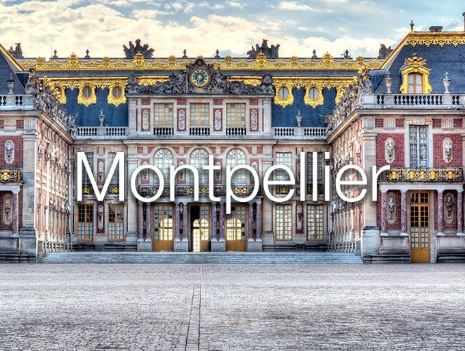

Montpellier
Since the 1990s, Montpellier has experienced one of the strongest economic and demographic growth in the country. Its urban area has experienced the highest population growth in France since the year 2000. Numbering 70,000, students comprise nearly one-fourth of its population, one of the highest such proportions in Europe.[4] Its living environment with one of Europe’s largest pedestrian area,[5] along with its rich cultural life and Mediterranean climate, explain the enthusiasm for the city, which is nicknamed the “Gifted”. Montpellier was nominated for “Best Emerging Culture City of the Year 2017” by the think tank LCD.[6] It is ranked as a Sufficiency city by the Globalization and World Cities Research Network.
Climate

Neighborhoods
- Montpellier-centre : historical centre (Écusson), Comédie, Gares, Faubourg Boutonnet, Saint-Charles, Faubourg Saint-Jaume, Peyrou, Les Arceaux, Figuerolles, Faubourg du Courreau, Gambetta, Clémenceau, Méditerranée, boulevard de Strasbourg, Le Triangle, Polygone, Antigone, Nouveau-Monde, Parc à Ballons, Les Aubes, Les Beaux-Arts, Saint-Lazare.
- Croix-d’Argent : avenue de Toulouse, Croix d’Argent, Mas Drevon, Tastavin, Lemasson, Garosud, Mas de Bagnères, Mas Nouguier, les Sabines, Lepic, Pas du Loup, Estanove, les Bouisses, Val-de-Crozes, Bagatelle.
- Les Cévennes : Les Cévennes, Alco, Le Petit Bard, Pergola, Saint-Clément, Clémentville, Las Rebès, La Chamberte, La Martelle, Montpellier-Village, Les Grisettes, Les Grèzes.
- Mosson : La Mosson, Celleneuve, La Paillade, les Hauts-de-Massane, Le Grand-Mail, Les Tritons.
- Hôpitaux-Facultés : Malbosc, Saint-Priest, Euromédecine, Zolad, Plan des 4 Seigneurs, Hôpitaux, IUT, Père Soulas, Universités, Vert-Bois, Hauts de Boutonnet, Aiguelongue, Justice, Parc zoologique de Lunaret, Agropolis.
- Port-Marianne : La Pompignane, Richter, Millénaire, Jacques Cœur, Consuls de Mer, Grammont, Odysseum, Montaubérou, La Méjanelle, Cambacérès.
- Prés d’Arènes : Les Prés d’Arènes, Avenue de Palavas, La Rauze, Tournezy, Saint-Martin, Les Aiguerelles, Pont-Trinquat, Cité Mion.
Neighborhood maps https://hoodmaps.com/montpellier-neighborhood-map
SOURCE: https://en.wikipedia.org/wiki/Montpellier
Montpellier details
https://www.map-france.com/Montpellier-34080/

Discover the most important neighborhoods of Montpellier!
The magic of Montpellier is found in each of its small streets, its medieval buildings, and among its many bars and cafés. Its corners always seem to have a surprise, because you may have passed the same place several times, but you will find it different on nearly every visit. The neighborhoods of Montpellier are each unique, and collectively form the iconic signature of the city.
Quartier Saint-Roch

This is one of the best-known neighborhoods in the city. It is in the heart of the historic center, and has an endless number of bars and restaurants. These are generally full both day and night. It is also possible to find various antique stores and design studios for those who love shopping. In addition, its church is one of the most visited by tourists; it is worth mentioning that students who live in the city love to sit on its steps to enjoy the sunny afternoons. Saint-Roch Square and Saint-Côme Square are the first meeting points in Montpellier.
Quartier Sainte-Anne
Quartier Les Arceaux

Les Arceaux is a quiet and pleasant neighborhood in the city, on the edge of the central area of Écusson. It is an area favored by many Montpellier residents who seek to live in an area close to the city center, but with peace and quiet. It is known for the Saint-Clément aqueduct, originally inspired by the architecture of the famous Pont du Gard. The market of regional producers and farmers along the aqueduct boulevard on Tuesdays and Saturdays make this neighborhood event a point of interest for residents and visitors.
Quartier Beaux Arts

Quartier Antigone

To get to this neighborhood takes only a couple of tram stops from the city center, or just cross the Polygone shopping center. Its neo-classical architecture is one of its greatest distinctions, and the sizeable number of green areas, parks, and fountains give the neighborhood a fresh and relaxed air. Here you will find the Olympic pool and the municipal library, which makes it very appealing to students after school hours.
Quartier Port Marianne

Time Difference
Time in Chicago https://www.timeanddate.com/worldclock/usa/chicago
Time in Montpellier (+7 Hours) https://www.timeanddate.com/worldclock/france/montpellier
9 AM in Chicago is 3 PM in Montpellier,
Noon in Chicago is 7 PM in Montpellier,
3 PM in Chicago is 10 PM in Montpellier
Transportation Map
Larger version. http://ontheworldmap.com/france/city/montpellier/montpellier-transport-map.html

